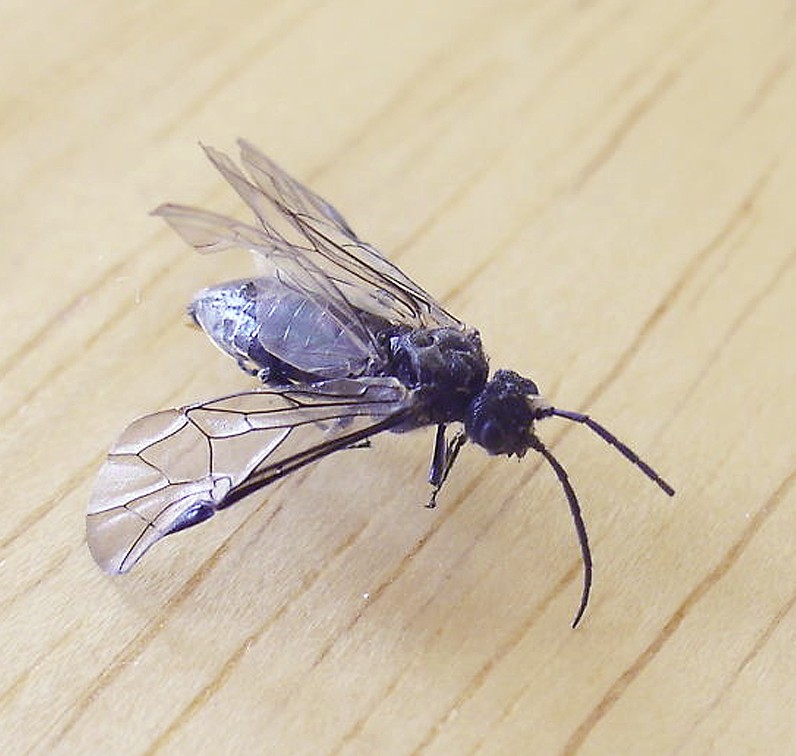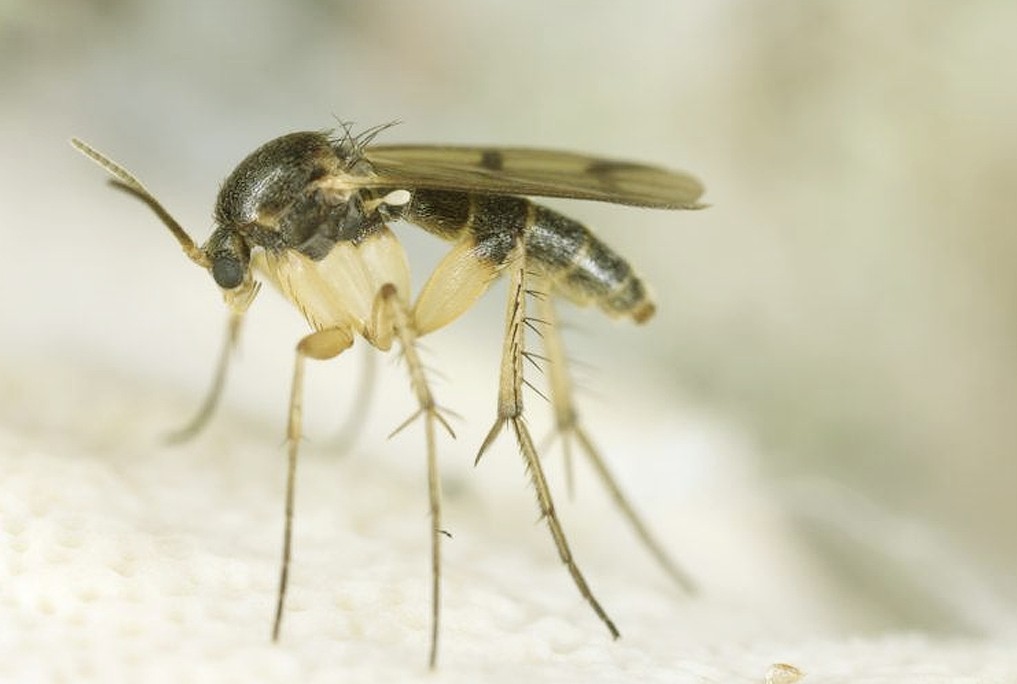Fungus Gnats
What are Fungus Gnats?
Fungus gnats are one of the most commonly found plant pests worldwide. They love damp, dark and moist places like soil, fungi, decaying organic matter, and potting mix. Although the adults are harmless, a female gnat can lay up to 300 eggs at once, which make the numbers multiply quickly.
The larvae cause maximum damage by infesting the plant roots. Be it, homeowners, gardeners or greenhouse operators, nobody likes the nuisance and damage caused by these gross-looking pests. This is why it becomes important to manage and control them. Let’s look at the Fungus gnats more closely to understand better what they can do and how to get rid of them.
Appearance and Size of Fungus Gnats

Picture of Fungus gnats
The adult Fungus gnats are usually 2.5 mm – 3 mm long and greyish-black in color. They have slender legs, segmented antennae and a pair of clear wings. The eggs are whitish-yellow in color, and the larvae have an elongated and transparent body with a hue of white color. The head is shiny and black in color. The pupae are generally whitish which turns darker as soon as they emerge into adults. These pests have a delicate appearance and are often confused with mosquitoes and shore flies.
Identification of Fungus Gnats

Although Fungus gnats are often confused with mosquitoes and shore flies, it’s quite easy to identify them. Unlike shore flies who have short antennae, the fungus gnats have segmented antennae which are apparently longer than their head. The gnats can fly, but they are weak flyers, and you’ll find them walking or hopping rather than flying. This is why, even if they are attracted towards light sources, they don’t tend to stay near the moist soil and don’t move inside the house. These pests have a Y-shaped pattern on their transparent wings which can be easily seen when they are at rest.
Distribution and Habitat of Fungus Gnats
The Fungus Gnats are found worldwide, and they are one of the most common bugs found in the United States of America. They can be spotted anywhere from greenhouses to the interior of the houses or buildings where they find moist soil.
Fungus gnats are usually attracted to dark and humid areas where they can feed on the vegetation, leaves, fungi and decaying plant matter. This is why the fungus gnats are seen mostly in swamps, flowerpots, meadows and forests. Not only this, some species of these gnats can even survive extreme weather conditions and live in mountainous, sandy and subantarctic regions. The fungus gnats can also be found in caves. They are found outdoors during winters when the temperature is cool and indoors throughout the year if the area is moist.
What do Fungus gnats eat?
The Fungus gnats love to eat fungi, mulch, compost, algae, lawn waste, leaf mould, root hairs, and decaying organic matter. Their host plants include Easter lilies, pepper, alfalfa, wheat, geraniums, clover, soybeans, cucumber, carnations, potatoes, lettuce, and corn.
Life cycle
Fungus gnats grow through four life stages- egg, larvae, pupa and adult, and produce many overlapping generations in just one year. The adult survives for about a week, and females lay up to 300 whitish-yellow eggs in damp organic media. It takes about three days and a temperature of 75 degrees Fahrenheit for the eggs to hatch.

Picture of Fungus gnat larvae
The hatched larvae feed in the same media and take around ten days to pupate. He pupae transform into full-grown adults in the next four days, and the cycle continues once they reproduce soon after that. The life cycle of these pests depends a lot on the temperature, and their development can stop for a certain period if the weather conditions are not favourable.
Pictures
Here are some fascinating Pictures of Fungus gnats:



Fungus Gnats Management
It’s a known fact that the adult fungus gnats can survive for just about a week. Since their life span is too short, they spend the majority of their lives as larvae or pupa. Since an adult female fungus gnat can lay up to 300 eggs and the larvae can cause extensive damage to the growing seedlings and young plants, it’s important to find methods that can effectively reduce the number of young gnats before they transform into fully grown adults. Once, the larvae population is managed, attempt getting rid of the adults too. Let’s look at some of the most effective ways to manage and control the population of fungus gnats before it is too late.
Clean Plant debris
Nothing makes fungus gnats happier than decomposed organic matter, and plant debris is no different. The gnats don’t mind laying eggs in places where there is a bunch of fallen leaves, fruits or flowers. This is why it’s important to keep your garden soil or any other soil in and around your home clean of plant debris. Try to avoid the use of compost in your potting mix, so that fungus gnats don’t make it their home. Instead, use a pasteurized potting mix if your house is infested by the gnats.
Avoid overwatering and improve drainage
Since fungus gnats are fond of moist soil, it’s important to take effective measures to stop them from laying eggs in the soil. The key is to refrain yourself from overwatering the plants and facilitate proper drainage. Try to keep the topsoil dry, clean standing water and don’t leave the saucers filled with water. Also, fix any leaks in the water system. Just so you know, the female adult gnats lay their eggs in the topmost soil since it is moist. You can confuse these pests by covering the top layer with sand giving them an impression that the soil is dry. However, if it’s too difficult for you to keep the soil dry and reduce watering, try to improve the drainage by introducing pertile to your container mix.
Fungus Gnats Control
If the situation goes out of hand and it seems nearly impossible to manage the infestation caused by the Fungus Gnats, it’s time that you should adopt more effective control measures to get rid of these unwanted pests. Below are few of the most fruitful methods to stop damage caused by these bugs which are no less than an infestation machine.
Sticky traps
When the nuisance caused by the fungus gnats starts getting on your nerves, use yellow sticky traps to get rid of them. The adult gnats get easily attracted towards the color yellow, so you can just buy sticky traps from a nearby store and depending on your convenience and need, place them horizontally or vertically on the surface of the soil. The gnats will get trapped as soon as they come in contact with the sticky traps. Remove the traps once they get caught, dispose them off and replace with new ones.
Potato slices
Since the larvae of fungus gnats are attracted towards raw potato chunks, you can use these chunks as a trap by placing thin slices of potato on the soil’s surface. Wait for 3-4 hours and then remove the slices, dispose of them and set new ones unless you don’t get rid of the gnats completely. It sounds gross but believe us when we say- it’s worth it!
Vinegar
Just like fruit flies, vinegar act as an excellent trap for adult fungus gnats too. Simply add some vinegar and dish soap in a disposable container or jar, mix it well and cover the jar tightly with plastic. Make small holes on the top of the jar so that the gnats can get inside easily. Now, place the containers nearby an infested area and wait. As soon as the gnats come in contact with the mixture, they’ll drown. Dispose of the jar and repeat the process until the gnats are controlled entirely.
Cinnamon powder
Cinnamon powder is one of the most potent fungicides that helps in reducing the larvae population by crashing their feeding source, i.e. fungus. All you need to do is spread the cinnamon powder on the surface of your container mix, and keep doing it for a few weeks to eliminate the larvae entirely.
Non-toxic Spray
Make a spray containing peppermint, sesame oil, and cinnamon powder and sprinkle it on the potting mix. If you don’t have access to these ingredients, purchase a non-toxic spray, “Flying Insect killer” as it contains all the three mentioned elements.
Biological Controls
When the infestation goes beyond control, and none of the above-mentioned methods work for you, its best to use biological control agents. You can apply Steinernema feltiae, Bacillus thuringiensis var. israelensis or Hypoaspis to control the infestation caused by fungus gnats in your potting mix. These products are quite expensive, but you would need to buy them if you don’t want any damage further. You can buy these biological controls either from a nearby retail nursery or order from a supplier.
We hope you had a good time knowing these interesting facts about Fungus gnats. So, next time, if you spot an infestation caused by these pests, don’t panic and just read through this article to take preventive and control measures.
